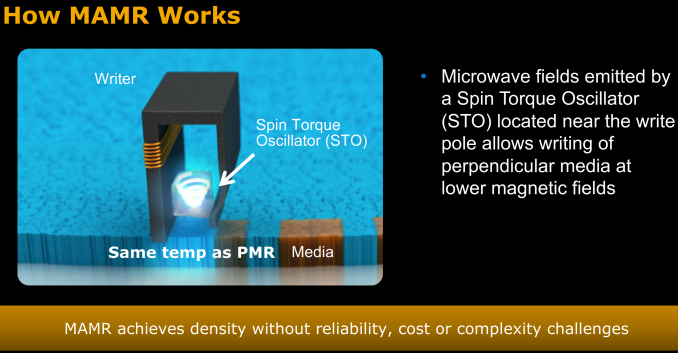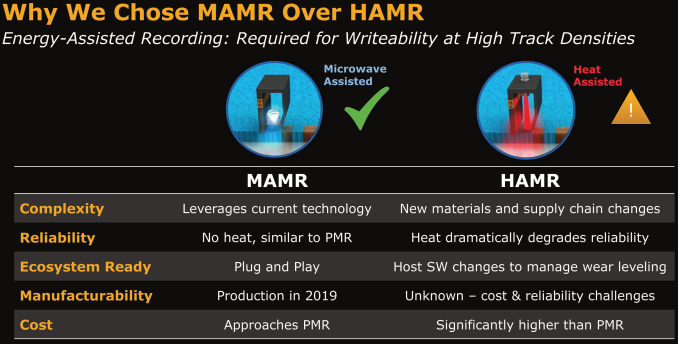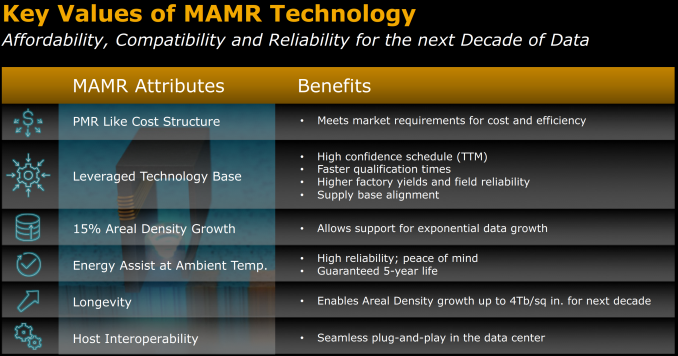Western Digital Stuns Storage Industry with MAMR Breakthrough for Next-Gen HDDs
by Ganesh T S on October 12, 2017 8:00 AM ESTMicrowave Assisted Magnetic Recording (MAMR)
The WD Breakthrough
Western Digital's Microwave Assisted Magnetic Recording (MAMR) drives use platters very similar to those in the current-generation PMR drives*. This means that the innovation to enable MAMR is mainly to do with the heads that perform read and write operations.
As part of the MAMR design, WD pointed out to its shift to the damascene process for building the bit grains as the key enabler for the MAMR breakthrough. The process allows them to fabricate a spin torque oscillator (STO) capable of creating precise energy fields without any additional overheads. The embedded oscillator in the head is tuned to generate microwaves with a frequency of 20-40 GHz, and this provides the 'energy-assist' to make it easier to write to the bits (technically it lowers the coercivity of the underlying recording media).
* Current drives use an aluminium substrate with a cobalt-platinum layer.
WD pointed out that MAMR requires absolutely no external heating of the media that could lead to reliability issues. The temperature profiles of MAMR HDDs (both platters and drive temperature itself) are expected to be similar to those of the current generation HDDs. It was indicated that the MAMR drives would meet all current data center reliability requirements.
Based on the description of the operation of MAMR, it is a no-brainer that HAMR has no future in its current form. Almost all hard drive industry players have a lot more patents on HAMR compared to MAMR. It remains to be seen if the intellectual property created on the HAMR side is put to use elsewhere.
Western Digital has talked about timeframes for the introduction of MAMR drives. They had working prototypes on display at the press and analyst event yesterday. WD's datacenter customers have their own four to six month qualification cycle, and MAMR drives for that purpose are expected to be out towards the middle of next year. Production-level HDDs based on MAMR technology are expected to start shipping in 2019.
Western Digital sees plenty of value in MAMR, and it is not hard to see why. MAMR technology allows for the bit densities of individual platters to scale to more than 4 Tb/sq.in. WD believes that it is well-positioned to bring 40TB drives by 2025 using MAMR alone.
Technologies such as SMR and TDMR are complementary to MAMR. Currently, WD does not use TDMR in any shipping enterprise drive, and SMR is restricted to a few host-managed models. It is possible that some MAMR drives will use those technologies to achieve higher capacity points compared to conventional drives. WD's working prototype on display was a helium drive (HelioSeal), but, WD again stressed that helium is not a compulsory requirement for MAMR drives. It was also confirmed that drives of 16TB and more would have to be MAMR-based.
In 2005, when the shift from longitudinal recording to PMR happened, most vendors managed to release drives based on the new technology within a few years of each other. The shift to helium in 2012, though expected by everyone in the industry, proved to be a big win for HGST - they had the markets that focus on high-capacity, or low-power, or low TCO to themselves for almost three years before Seagate eventually caught up. Toshiba is yet to release a helium drive publicly. It is going to be interesting to see how Seagate and Toshiba respond to this unexpected MAMR announcement from Western Digital.
The players in the hard drive industry have a robust cross-licensing program, and it is highly likely that other manufacturers will not face significant patent bottlenecks in bringing out MAMR drives on their own. WD stressed that the development is a multi-year effort, particularly if the heads are still being manufactured in the old dry pole process.
High-volume mature hard drives are often manufactured with the help of third-party suppliers - such as Showa Denko for the recording media and TDK for the heads. In the case of the MAMR drives, WD mentioned that all the components are being designed and manufactured in-house. It is possible for the competition to catch up faster if some of the third-party manufacturers are further along in their own R&D. In particular, TDK has been investing in MAMR R&D recently too. Toshiba has also shown interest in the same, but it is not clear how far along they are in the commercial development cycle. Currently, we believe WD has a clear lead in MAMR technology. It just remains to be seen how long it takes for the competition to catch up.














127 Comments
View All Comments
HollyDOL - Thursday, October 12, 2017 - link
Actually those definitions are not globally same, see https://en.wikipedia.org/wiki/Long_and_short_scale...Flunk - Thursday, October 12, 2017 - link
It's a good thing that we're typing in English where all the major countries have settled on the short scale.sonny73n - Friday, October 13, 2017 - link
Back in school days, I was taught that1 KB = 1024 Bytes
1 MB = 1024 x 1024 Bytes
1 GB = 1024 x 1024 x 1024 Bytes
and so on.
So how is 40 trillions bytes equal to 40TB?
Strom- - Friday, October 13, 2017 - link
Binary multiples were standardized in 1998 https://physics.nist.gov/cuu/Units/binary.html1 KB = 1 kilobyte = 1000 bytes
1 KiB = 1 kibibyte = 1024 bytes
One big reason for the confusion is that Microsoft chose not to update their File Explorer code to the new standards in 1998. They still haven't done it, so now we're at 20 years of people learning falsehoods by using Windows.
KAlmquist - Friday, October 13, 2017 - link
When a word acquires a new meaning, that doesn't make the old meaning disappear. So there are two definitions of kilobyte:1. 1024 bytes
2. 1000 bytes
This may create confusion--indeed I'm pretty sure that the whole point of introducing the second definition was to create confusion--but I don't see how you can blame Microsoft for that.
letmepicyou - Thursday, October 12, 2017 - link
The problem lies with the operating system creators considering 1 TB as 1024 GB. All that needs to happen is a simple (ok, maybe not SIMPLE, but not super complex either) rewrite to view storage in blocks of 1000 vs 1024. Then OS and HD would unite in a brilliant flash of unity unseen since...ahh...special relativity and quantum mechanics? No, AT&T and Sprint? No, no...Star Wars and Disney? Oh never mind...it'd be GREAT!06GTOSC - Thursday, October 12, 2017 - link
Just for the purpose of making hard drive purchasers who are ignorant more content? No. The OS agrees (and should) with the reality of binary. Not marketing.rrinker - Thursday, October 12, 2017 - link
Dog and cats, living together...gammaray - Thursday, October 12, 2017 - link
How? there is a reason why it's 1024. Computers are based on the binary system. Hard drives are measured in power of 2 ( 128, 256, 512, 1024 etc)HollyDOL - Saturday, October 14, 2017 - link
Indeed, I have yet to see a drive with sector size of 4000 instead of 4096 bytes :-)